Occupational environment monitoring at the factory producing insecticide spray
99,000 ₫
Note: The above price is calculated for one sample, the price may fluctuate depending on the area of the environment to be monitored and the movement of the market. For more accurate price support, please refer to the quotation table or contact directly with our consulting staff.
Environmental monitoring of insecticide spray manufacturing factories is a session of collecting, analyzing, and evaluating factors in the workplace that may be harmful to the health of workers.
Table of Contents
Toggle1. Overview of the Insecticide Spray Manufacturing Plant
a. What is an Insecticide Spray Manufacturing Plant?
A manufacturing plant for insecticide sprays is a specialized facility designed to produce insecticide sprays, also known as insect-repelling sprays. An insecticide spray is a device used to disperse substances that kill or repel insects such as mosquitoes, flies, cockroaches, ants, and fleas.
Insecticide spray plants typically feature modern production lines for processing components such as the container, spray nozzle, pump mechanism, control valve, and spraying mechanism. These plants employ industrial manufacturing processes to assemble and quality-test their products.
The production process of insecticide sprays includes research and development, design, fabrication, assembly, and final quality testing. These plants usually supply insecticide sprays to companies or brands specializing in health and safety products, retail stores, and household product distributors.

b. Production stages in an Insecticide Spray Manufacturing Plant
Production stages in an insecticide spray plant may include the following steps:
- Research and Development: Exploring and developing new formulas, ingredients, and technologies to create effective insecticide sprays. Research may involve testing insecticidal compounds and evaluating their safety and effectiveness.
- Design: Designing components of the insecticide spray, such as the container, nozzle, pump mechanism, control valve, and spraying mechanism. Design ensures leak-proof, user-friendly, and high-performance spraying.
- Fabrication and Component Manufacturing: Components are fabricated from materials such as plastic, metal, and rubber. Fabrication may include injection molding, compression molding, CNC machining, and other processes to produce precise, high-quality parts.
- Assembly: Components are assembled into complete insecticide sprays, including the container, nozzle, pump, and control valve. Electronic components such as switches or indicator lights may also be installed.
- Quality Testing: After assembly, sprays are tested to ensure proper operation and compliance with safety and performance standards. Tests may include pressure checks, leak tests, spray performance, and electrical safety checks.
- Packaging: Completed sprays are packaged in suitable materials such as cartons, plastic bags, or protective packaging to ensure safety and quality during transportation.
- Transport and Distribution: Packaged sprays are transported to distributors, retail stores, or end customers for use.

c. Machinery used in an Insecticide Spray Manufacturing Plant
In an insecticide spray plant, common machinery and equipment include:
- Plastic Injection Molding Machine: Used to manufacture plastic components like containers, caps, and small parts by injecting plastic into molds.
- Plastic Extrusion Machine: Used to produce larger or more complex plastic parts through extrusion and thermal processing.
- CNC Machining Center (Computer Numerical Control): Used for precision machining of metal components, performing cutting, drilling, milling, and shaping.
- Welding Machine: Used to weld metal components together to form the spray framework.
- Spray Painting Machine: Applies protective or decorative coatings to the sprays.
- Printing and Embossing Machine: Prints labels, logos, or product information on the spray surfaces.
- Pressure Testing Machine: Ensures proper operating pressure of the sprays.
- Leak Testing Machine: Checks for leaks in the sprays to prevent unwanted fluid leakage.
- Electrical Safety Testing Machine: Ensures electrical components comply with safety standards.

d. Occupational hazards for workers in an Insecticide Spray Manufacturing Plant
Workers in insecticide spray plants may face several occupational hazards due to exposure to chemicals and workplace conditions. Common occupational diseases include:
- Respiratory diseases: Caused by inhalation of chemical fumes from insecticides, including pneumonia, asthma, sinusitis, and bronchitis.
- Skin allergies: Contact with chemicals can lead to irritation, dermatitis, rashes, itching, redness, or long-term allergic reactions.
- Digestive issues: Exposure through skin or ingestion may cause nausea, abdominal pain, vomiting, and digestive disturbances.
- Nervous system effects: Certain chemicals may negatively impact the nervous system, causing dizziness, headaches, anxiety, insomnia, or other neurological symptoms.
- Cardiovascular effects: Long-term exposure to some chemicals may affect the heart and circulatory system, leading to hypertension, arrhythmia, or other cardiovascular issues.
Proper personal protective equipment (PPE) and safe working procedures are critical in insecticide spray plants, along with strict compliance with chemical handling guidelines.

e. Popular types of Insecticide Sprays on the market
Common types of insecticide sprays include:
- Hand Sprays: Small, portable sprays with adjustable nozzles, typically 0.5–2 liters in capacity.
- Handheld Sprayers: Larger versions with handles and hoses for covering bigger areas, usually 5–12 liters.
- Rechargeable Sprayers: Battery-powered, large-capacity sprays (10–20 liters) for professional or large-scale use.
- Pressure Sprayers: Use water or compressed air for spraying, suitable for gardens, ponds, or large areas.
- Automatic Sprayers: Activated by sensors or timers, used in greenhouses, warehouses, or automated pest control systems.
2. Overview of Occupational Environment Monitoring Services
a. What is Occupational Environment Monitoring in an Insecticide Spray Plant?
Occupational environment monitoring (or workplace environmental measurement) in an insecticide spray plant involves collecting, evaluating, and analyzing environmental factors to promptly address hazards, minimize health impacts on workers, and prevent occupational diseases. This monitoring is mandatory for insecticide spray plants.
Monitoring protects workers’ health, which is vital as employees are the primary resource creating profit for businesses. Prolonged exposure to hazards above allowed limits can lead to occupational diseases.
REGISTER FOR OCCUPATIONAL ENVIRONMENT MONITORING SERVICE
b. Nam Viet’s Occupational Environment Monitoring Program
Nam Viet’s program is developed by monitoring engineers in occupational safety and environmental protection. Using modern measurement methods, it monitors air, water, microclimate, physical factors, dust, and other workplace elements. This program ensures a safe working environment and protects workers’ health.
It also plays a key role in researching and developing solutions to improve workplace environmental quality. With a dedicated professional team, Nam Viet’s exclusive program is a breakthrough in occupational safety and environmental management in Vietnam.

c. Standardization in workplace environmental measurement
Standardization ensures the accuracy and reliability of measurement results. Nam Viet follows recognized standards and procedures by the Ho Chi Minh City Department of Health.
All measurements are performed by highly trained monitoring specialists, ensuring reliable data for managers and experts to make precise, valuable decisions for worker health and environmental protection.
Standardized measurement processes demonstrate Nam Viet’s commitment to safe workplaces and contribute to improving occupational safety and environmental management in Vietnam.
d. Reporting results of monitoring in the Insecticide Spray Plant
Monitoring results are prepared according to Form No. 04, Appendix III of Decree 44/2016/ND-CP, in two copies: one for the contracting enterprise and one kept by the monitoring organization.
Records must be kept indefinitely according to the law.

e. Frequency of occupational environment monitoring as per legal regulations
According to Clause 2, Article 18, Labor Safety and Hygiene Law 84/2015/QH13, employers must conduct workplace environment monitoring at least **once per year**.
f. Deadline for submitting monitoring results
Reports must be submitted before December 31 annually to the local Department of Health where the facility operates. Any changes in technology, production processes, or facility upgrades that may create new hazards must be updated in the occupational hygiene records.
g. Penalties for violations regarding occupational environment monitoring for employers
According to Article 27, Decree 12/2022/ND-CP dated January 17, 2022:
- Clause 2: Fines from 2,000,000 – 5,000,000 VND for not publicly notifying workers about monitoring results and hazard assessments.
- Clause 3: Fines from 20,000,000 – 40,000,000 VND for failing to conduct occupational environment monitoring as required by law.
- Clause 4: Fines from 40,000,000 – 60,000,000 VND for colluding with monitoring organizations to falsify monitoring results without reaching criminal liability.
3. Harmful Environmental Factors for Workers in Insecticide Spray Production Factories
Workers in insecticide spray production factories may be exposed to several harmful environmental factors. The main potential factors affecting workers’ health include:
- Chemicals: Insecticide spray factories use many chemicals during production, including components of insecticides and other chemical compounds. Exposure to these chemicals can cause skin irritation, respiratory inflammation, digestive issues, and may harm the nervous system.
- Dust and particles: The production process can generate dust and particles from plastic and metal processing. Inhaling dust and particles may cause respiratory irritation and other respiratory health problems.
- Noise: Machinery and equipment in the production factory can generate high noise levels. Continuous loud noise can cause stress, reduce concentration, and harm hearing.
- Temperature and humidity: The working environment in the factory may have unstable temperature and humidity. Extreme conditions can cause work difficulties, fatigue, and affect the overall health of workers.
- Electrical safety: There may be electrical safety risks due to the use of machinery and electrical equipment. Workers can be exposed to electrical currents, leading to danger and accidents.
- Waste handling: The production process can generate waste such as packaging, old spray bottles, and leftover chemicals. Improper waste management may cause environmental pollution and harm human health.
REGISTER FOR OCCUPATIONAL ENVIRONMENT MONITORING SERVICE
4. Measures to Improve the Working Environment in Insecticide Spray Factories
To improve the working environment in insecticide spray production factories and protect workers’ health, the following measures can be applied:
- Ensure ventilation and exhaust systems: Provide an effective ventilation system to reduce chemical toxins and dust in the air. Use dust extraction systems and fans to remove pollutants from the workspace.
- Training and guidance: Ensure that all workers are trained and guided on safe working procedures and the use of personal protective equipment. This includes guidance on safe handling and exposure to chemicals, and proper waste management.
- Use personal protective equipment (PPE): Ensure that all workers are provided with and properly use PPE such as safety goggles, masks, gloves, chemical-resistant clothing, and safety shoes. This is essential to protect workers from direct exposure to chemicals and dust.
- Chemical management: Implement safe procedures for storing, using, and transporting chemicals. Ensure chemicals are stored properly in safe containers, kept in designated areas, and that recycling and waste disposal are done appropriately.
- Equipment inspection and maintenance: Ensure that machinery and equipment are regularly inspected and maintained to guarantee safe and effective operation. Repair or replace damaged equipment and ensure safe use.
- Periodically conduct occupational environment monitoring in factories, collecting and analyzing harmful factors for workers, and adjusting to reduce risks to prevent occupational diseases.
5. Benefits of Periodic Monitoring in Insecticide Spray Factories
An Toan Nam Viet provides your business with outstanding benefits when using occupational environment monitoring services as stipulated in Decree 44/2016/ND-CP on managing and controlling harmful factors in the working environment affecting workers.
- Your business can proactively control harmful factors in workshops or factories.
- Receive recommendations on measures to minimize harmful factors and improve the quality of the working environment.
- Indirectly protect human resources, the key factor in business development.
- Reduce the impact of occupational diseases on workers’ health, lowering future treatment costs.
- Improved worker health leads to better product quality and consistent production output.
- Comply with labor safety regulations and avoid legal risks.
- Enhance credibility and professionalism in all aspects, raising your business brand.
Nam Viet’s environmental monitoring service is a solution to minimize the harmful effects of occupational diseases, contributing to a clean and high-quality working environment.

6. National Occupational Environment Monitoring Center
The National Occupational Environment Monitoring Center of Nam Viet is a professional unit specializing in monitoring and measuring workplace environmental quality across all provinces in Vietnam. With an experienced team of monitoring specialists, the center uses modern measuring equipment to ensure accuracy and reliability.
In addition to monitoring services, the center assists clients in planning, handling, and tracking occupational environment issues. With the motto “Customer-Centric,” the center prioritizes customer satisfaction, meets all client needs, and is committed to providing the best solutions for businesses.
REGISTER FOR OCCUPATIONAL ENVIRONMENT MONITORING SERVICE
With investments in technology, equipment, and human resources, Nam Viet’s monitoring center has become one of the most reputable units in occupational environment monitoring in Ho Chi Minh City with the following goals:
- We always value our brand reputation and the quality of our services.
- We provide clients with the best and most suitable solutions possible.
- Along with a team of experienced Masters and Engineers dedicated to protecting the environment and benefiting businesses.
- By choosing Nam Viet Environmental Monitoring, your company will receive professional service from experts and enjoy the best cost benefits.
The occupational environment monitoring process at Nam Viet includes the following basic steps:
- Before conducting monitoring, we ensure that all machinery and equipment are adjusted and calibrated according to legal regulations.
- Carry out the monitoring process in full compliance with the commitment to the Department of Health.
- Report monitoring results honestly to the employer.
- If results indicate unsafe conditions for workers, Nam Viet will provide solutions, and the workplace will implement the following:
- Implement measures to improve working conditions, minimizing harmful factors and preventing occupational diseases.
- Organize health checks to detect occupational and work-related diseases early for employees in unsafe environments.
- Provide compensation in kind for employees according to labor law regulations.

7. Occupational Environment Monitoring Quotation
To help businesses conduct occupational environment monitoring professionally and effectively, Nam Viet provides clients with a quotation for occupational environment monitoring services that is high-quality and reasonably priced.
- Our quotation provides detailed information on the costs of monitoring services we offer, including expenses for travel, measurements, analysis, and reporting. Clients can be confident in the accuracy and reliability of our monitoring reports.
- We are committed to offering the most competitive and reasonable prices on the market and are ready to promptly and professionally answer any questions regarding monitoring services.
- With Nam Viet’s quotation, clients can easily select service packages that suit their needs. We are committed to providing the highest satisfaction with professional service quality.
No comments yet

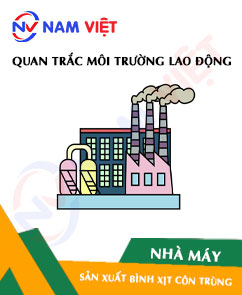
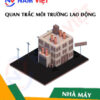
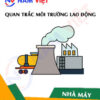

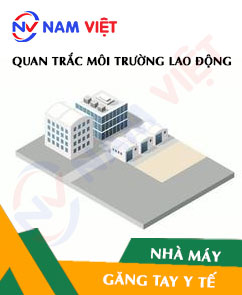
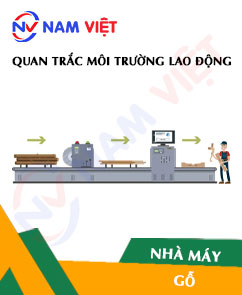





Review Occupational environment monitoring at the factory producing insecticide spray
There are no reviews yet.